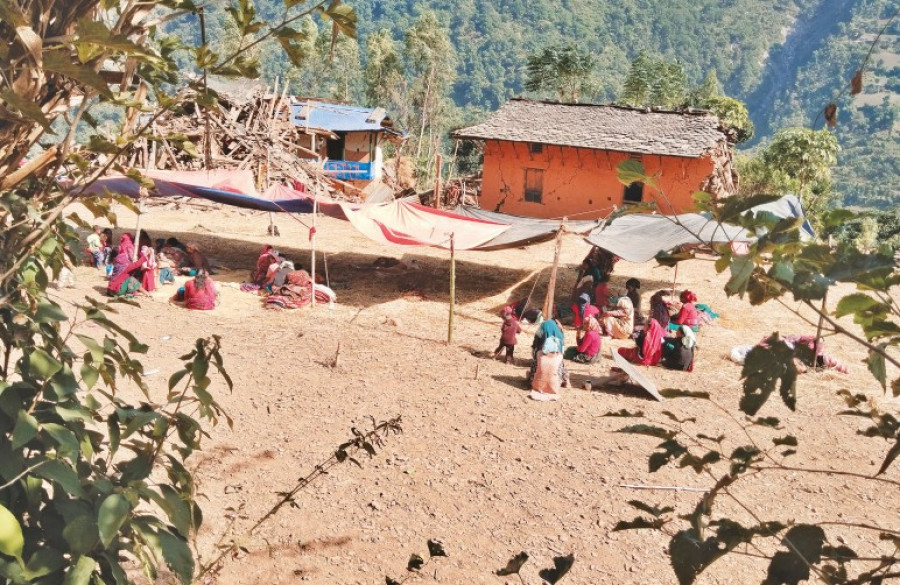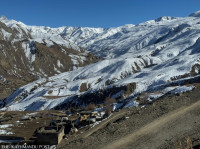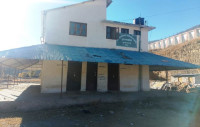Karnali Province
Cold-related ailments have claimed several lives in Jajarkot after the November 3 earthquake
Thousands of people including many new mothers have been forced to take shelter under makeshift plastic tents amid the growing winter cold.
Arjun Poudel
On Monday, a one-month-old baby from the Bheri Municipality of Jajarkot died of pneumonia.
Doctors at the district hospital, where the baby was rushed for treatment after his condition deteriorated, had referred the baby to Nepalgunj upon arrival at the hospital emergency. However, the baby succumbed to the disease, before his parents could take him anywhere.
At least 12 people including children have died from cold-related ailments since the magnitude 6.4 earthquake rocked Jajarkot and West Rukum of Karnali Province on November 3, local health officials said, requesting anonymity because they were not authorised to speak to the media. At least 154 people were killed and thousands displaced in the immediate aftermath.
“Yes, a one-month baby died of pneumonia in the district hospital on Monday,” said Krishna Bahadur Khatri, an official at the Health Office, Jajarkot. “We don’t have a record of the actual number of deaths from cold-related ailments, but small children and elderly people have been the worst affected.”
Other officials the Post talked to said that they do not know the causes of deaths of those who died at home.
Pneumonia, an infection of the lungs caused by various types of bacteria, viruses and fungi, is the number one killer of children under five in Nepal. It kills more children annually than malaria, tuberculosis and HIV combined.
Of the total under-five mortality rate, 15 percent die of pneumonia, according to the World Health Organization.
However, data from the Health Management Information System under the Department of Health Services shows that of the total deaths of children under five years of age, around 30 percent died of pneumonia in Nepal.
Doctors say a rise in cases of cold-related ailments including pneumonia during winter is a common phenomenon which happens throughout the country and children and elderly people are highly vulnerable to developing complications and dying. They say most of the viruses—adenovirus, rhinovirus, and seasonal influenza—become active in the winter season.
Saving the displaced people residing in the open or under makeshift shelters is a big challenge, as they are at heightened risk of getting cold-related ailments, according to them.
“Viruses themselves cause pneumonia and in winter most viruses become active,” said Dr Srijana Shrestha, former dean of the School of Medicine at the Patan Academy of Health Sciences. “Extra precaution should be taken to save the most vulnerable people—children, pregnant women and elderly people.”
Thousands of people including many new mothers in the quake-hit areas have been forced to take shelter under makeshift plastic tents since the November 3 earthquake. It is reported that people started getting sick due to falling temperatures.
“Even youths and strong people can fall ill from cold if they stay in makeshift shelters,” said Kali Bahadur Oli, a health official at the Health Office, West Rukum. “We don’t have official information on any deaths from cold-related ailments, but it is understandable that elderly people and children are among the most affected\.”
According to officials, most houses in the highly-affected areas have suffered damage. The jolts have caused cracks in the walls of these houses rendering them unlivable.
“A lot of people have also been affected by the dust, as many have set up makeshift shelters near roads, which are full of dust and dirt,” Oli said.
Public health experts say along with saving people from cold-related ailments, preventing possible outbreaks of communicable diseases—water-borne and vector-borne—is the main challenge in the areas hit hard by earthquakes.
Along with houses, toilets were also destroyed in the earthquake. Officials say the destruction of toilets increases open defecation, increasing the risk of contamination of water sources. The risk of vector-borne diseases—malaria, dengue, kala-azar and scrub typhus among others—spreading also increases, according to experts.




 11.12°C Kathmandu
11.12°C Kathmandu











